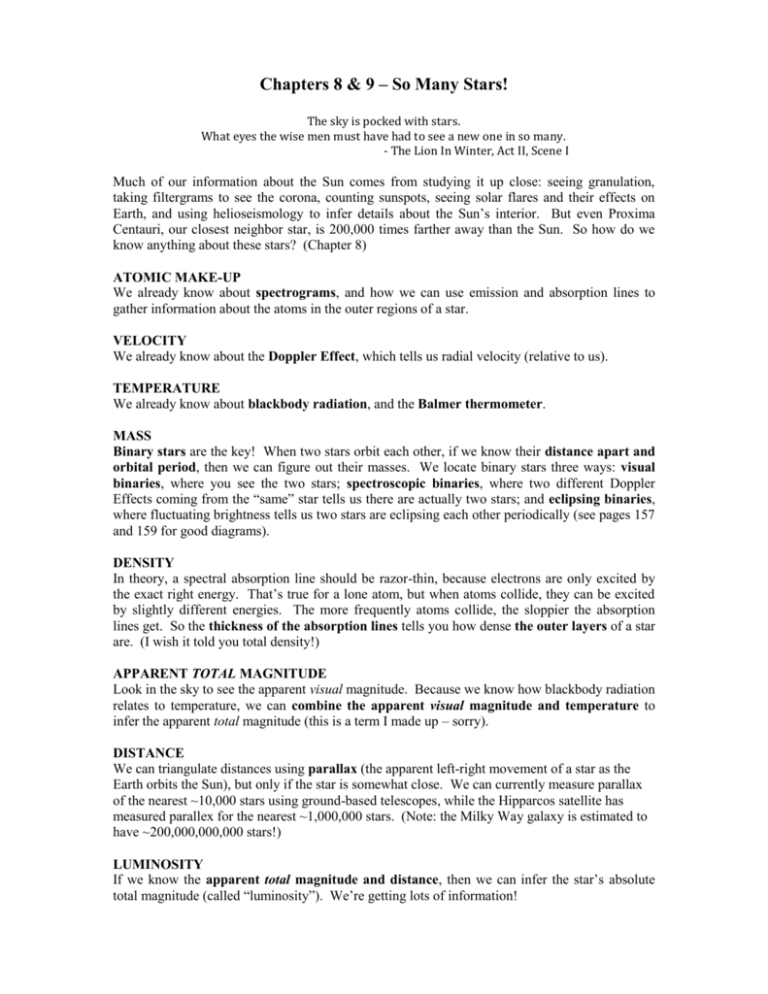Chapters 8 & 9 – So Many Stars!
advertisement

Chapters 8 & 9 – So Many Stars! The sky is pocked with stars. What eyes the wise men must have had to see a new one in so many. - The Lion In Winter, Act II, Scene I Much of our information about the Sun comes from studying it up close: seeing granulation, taking filtergrams to see the corona, counting sunspots, seeing solar flares and their effects on Earth, and using helioseismology to infer details about the Sun’s interior. But even Proxima Centauri, our closest neighbor star, is 200,000 times farther away than the Sun. So how do we know anything about these stars? (Chapter 8) ATOMIC MAKE-UP We already know about spectrograms, and how we can use emission and absorption lines to gather information about the atoms in the outer regions of a star. VELOCITY We already know about the Doppler Effect, which tells us radial velocity (relative to us). TEMPERATURE We already know about blackbody radiation, and the Balmer thermometer. MASS Binary stars are the key! When two stars orbit each other, if we know their distance apart and orbital period, then we can figure out their masses. We locate binary stars three ways: visual binaries, where you see the two stars; spectroscopic binaries, where two different Doppler Effects coming from the “same” star tells us there are actually two stars; and eclipsing binaries, where fluctuating brightness tells us two stars are eclipsing each other periodically (see pages 157 and 159 for good diagrams). DENSITY In theory, a spectral absorption line should be razor-thin, because electrons are only excited by the exact right energy. That’s true for a lone atom, but when atoms collide, they can be excited by slightly different energies. The more frequently atoms collide, the sloppier the absorption lines get. So the thickness of the absorption lines tells you how dense the outer layers of a star are. (I wish it told you total density!) APPARENT TOTAL MAGNITUDE Look in the sky to see the apparent visual magnitude. Because we know how blackbody radiation relates to temperature, we can combine the apparent visual magnitude and temperature to infer the apparent total magnitude (this is a term I made up – sorry). DISTANCE We can triangulate distances using parallax (the apparent left-right movement of a star as the Earth orbits the Sun), but only if the star is somewhat close. We can currently measure parallax of the nearest ~10,000 stars using ground-based telescopes, while the Hipparcos satellite has measured parallex for the nearest ~1,000,000 stars. (Note: the Milky Way galaxy is estimated to have ~200,000,000,000 stars!) LUMINOSITY If we know the apparent total magnitude and distance, then we can infer the star’s absolute total magnitude (called “luminosity”). We’re getting lots of information! SIZE Suppose we find a new star, and the Balmer thermometer tells us that its photosphere is cooler than the Sun’s photosphere. But from its apparent magnitude and distance, we know it has the same luminosity as the Sun, so it’s radiating the same total amount of energy. To make up for the lower temperature, the star must have a larger photosphere than the Sun’s: it must be bigger! Comparing temperature and luminosity tells us size. HERTZSPRUNG-RUSSELL DIAGRAM When we graph luminosity compared to temperature, we find surprising patterns. About 90% of stars fall on the main sequence. There is also a group of cool, large stars called giants, and a smattering of supergiants. (Notice the vertical scale goes up quickly: those big stars are BIG!) Lastly, there are hot, small stars called white dwarfs. (See pages 152 & 165.) (Absorption line width, it turns out, is related to height on the HR diagram. Combine that with temperature, and we can infer what a star’s luminosity should be. Compare this to what we actually see, and we can infer the star’s distance. This method is called spectroscopic “parallax”. We use it for distance if we can’t measure actual parallax.) The HR diagram presents a big question: Why do stars show these patterns? We need a theory of how stars are born, how they live, and how they die. Let’s start with birth! – CHAPTER 9 – If you look through a telescope at the middle star in the “Orion’s dagger” asterism, it’s bizarrely fuzzy. In fact, it is not a star at all, but a giant cloud of gas and dust, called a nebula (Latin for “cloud”). We can see the Great Nebula of Orion because it is lit up from inside by newly-formed stars; this is called an emission nebula. Some nebula are not lit from inside, so we “see” them because they block the view of the stars behind them (see page 171); these are called dark nebula. A very dusty nebula will scatter starlight and appear blue-ish, just like our atmosphere; this is called a reflection nebula. The gasses in a nebula attract each other through gravity, so the nebula starts shrinking. Small areas of high density might occur by chance, and they might occur due to the shockwave of a nearby explosion. However they occur, a local high density area will attract more mass, becoming more and more dense, getting hotter and hotter. How much mass does this protostar pull in? This is a key question! If the protostar weighs less than 0.08 solar masses, then the center will never get hot enough to start hydrogen fusion, and the “star” fails to form. This is called a brown dwarf. If the protostar weighs at more than 0.08 solar masses, the center gets hot enough to start hydrogen fusion. Finally, the nuclear explosion energy pushing out can counteract the gravity pulling in, and hydrostatic equilibrium is reached. A star is born! A very massive protostar, say 50 solar masses, will form very quickly due to its huge gravity. It’s core will also become extremely hot. If the core heats to over 16,000,000 degrees, hydrogen fusion can occur via the CNO cycle, which is more efficient than the proton-proton chain. (Our Sun just missed the cutoff, at 15,000,000 degrees.) Large stars also burn through their hydrogen fuel much faster than small stars. Our Sun will be on the main sequence for about 10 billion years (halfway there!). A star of 15 solar masses will be on the main sequence for only 10 million years! All new stars lie on the HR diagram main sequence. It turns out the giants, supergiants, and white dwarves are dead or dying stars. But that’s next class… if phrases like “only 10 million years” make you feel small… White Dwarf By John Updike Welcome, welcome little star! I’m delighted that you are Up in heaven’s vast extent No bigger than a continent. Relatively minuscule, Spinning like a penny spool, Glinting like a polished spoon, A kind of kindled demi-moon, You offer cheer to tiny Man ‘Mid galaxies gargantuan – A little pill in endless night, An antidote to cosmic fright. Homework Read chapter 8 Read chapter 9 review questions on page 167: 1, 2, 3, 4, 5, 7, 13, 16 review questions on page 195: 4, 9, 12, 15








